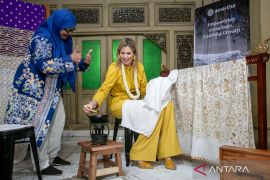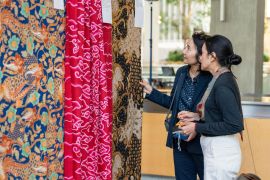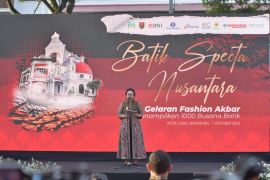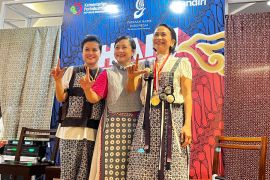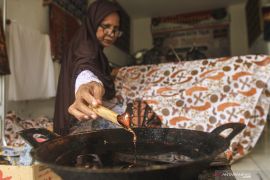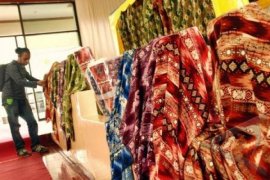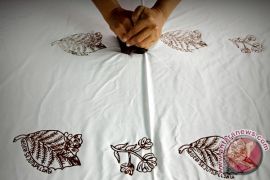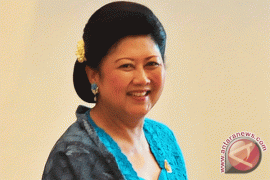On May 20 the Trade Ministry designated Batam city in Riau Islands province as ASEAN batik trade center after it has been agreed on during the ASEAN summit in Jakarta early in May 2011.
"To support Batam as ASEAN batik trade center, we are developing contemporary batik with bright colors as typical souvenirs," Batam`s trade and industry, energy and mineral resources spokesman Ahmad Hijazi said in Batam over the weekend.
He said contemporary batik with cotton material was very suitable for hot area like in Batam.
"In addition, foreign tourists are interested so much in the contemporary batik," Ahmad said.
Meanwhile, spokesperson of Batam`s Indonesian Chamber of Commerce and Industry (Kadin), Nada Faza Soraya, said it was the Kadin Indonesia Foundation and Indonesian Batik Foundation that had asked the Trade Ministry to name Batam as a batik trade center in the ASEAN region.
Nada said due to its strategic location and sea border with several Asean countries, the city was designated as the Asean batik trade center.
In late 2009, the UN Educational, Scientific and Cultural Organization (UNESCO) officially recognized batik as an Indonesian cultural heritage.
Batik was considered not only as part of Indonesian cultural heritage but also recognized as a representation of humanity`s culture for its rich value and cultural inheritance.
With the determination of Batam as batik trade center in Asean, she said Indonesian batik industry was expected to be more prospective.
Therefore, Nada added that Kadin along with several other batik foundations would conduct batik education and its familiarization.
According to her, batik-related education was necessary for Indonesian community to know more about Indonesian cultural riches which have been recognized internationally.
"The Indonesian community need to know various kinds batik motif after it has been internationally recognized," Nada said, adding that every detail of batik had the value of a decent life that has to be maintained.
According to her the color and motif of batik also reflects the regions in Indonesia because every region has its own typical motif.
"Batik is found all over Indonesia and every area in the country has its own motif of batik," she said.
Nada said the designation of Batam as ASEAN batik trade center was something extraordinary for the small but busy island with hundreds of multinational-owned factories and shopping centers as the gateway to the Riau Islands.
Located only 20km from Singapore and 25km from Johor in Malaysia, Batam is Indonesia`s equivalent to China`s Special Economic Zones (SEZs) - a place where the nation`s economic planners test new economic policies and ideas.
The island is an industrial hub with electronics factories, a large and growing ship repair industry and an even larger oil service sector.
"Our struggle to make Batam ASEAN batik trade center is finally realized and therefore all stake holders are expected to give more of their attention, especially to batik development from various areas across the country," Nada said.
She added that as ASEAN batik trade center, Batam would have a very strategic position for batik products and market that have to be worked out in an optimal way.
No wonder Batam city administration will include batik craft into the Medium-term Development Plan 2011-2016 to support Batam as ASEAN as well as national batik trade center.
"Batik is included into the Medium-term Development Plan 2011-2016 in our effort to support the designation of Batam as ASEAN and national batik trade center," Batam City Planning Board chief Wan Darussalam said in Batam recently.
He said the local government fully supported the designation of Batan as ASEAN batik trade center during ASEAN summit in Jakarta early this month.
According Wan Darussalam, the medium-term development plan has been arranged by the city government and would be submitted to the Regional Legislative Assembly (DPRD) before the end of the year.
Meanwhile, Batam Mayor Ahmad Dahlan said the local government in cooperation with other batik companies outside the city would develop garment industry on Batam island to support ASEAN batik trade center.
Although Batam was not a batik-producing city, Ahmad Dahlam expressed optimism that ASEAN batik trade center would be successful because the local craftsmen have created around 10 designs and motives of batik that have been registered at Industry Ministry for the copyright.
Therefore Jodoh wholesale market in the city of Batm is deemed necessary to be turned into a place for batik transaction activity.
"Jodoh wholesale market is not really well-kept and I think it is better to turn it into a batik market to support the designation of Batam as ASEAN batik trade center," Batam city councilor Rekaveny said in Batam on Sunday.
He said that as the center of ASEAN batik trade, Batam needs a center of batik selling and buying.
According to him, batik trade center should be at an open market with strategic location like Jodoh wholesale market.
"It is better for the batik trade center not to be in a building but in an open market instead," Rekaveny said.
He said Jodoh wholesale market was considered best suited to be turned into a batik central market in Batam.
Meanwhile, Riau Islands deputy Governor Soerya Respationo said batik development in the district could be included into revised regional budget 2011.
"I support batik development but the regional budget for it should be made with regional legislative assembly (DPRD)," Soerya said.
Therefore he called on all the relevant parties including the DPRD to support the designation of Batam as an ASEAN batik center to preserve the ancestral culture. (*)
Reporter: By Otniel Tam
Editor: Kunto Wibisono
Copyright © ANTARA 2011
